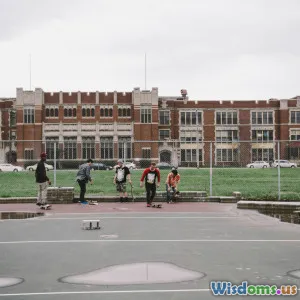
Art Movements and Their Social Impact
8 min read Explore how art movements shape society and reflect cultural changes, driving commentary and action across generations. (0 Reviews)
Art Movements and Their Social Impact
Art has always been a window into the soul of society. From ancient times to the modern era, artistic expression has been an essential means of reflecting, critiquing, and sometimes combating, the social issues of its time. This article delves into various art movements throughout history, examining their unique characteristics and the social impacts they engendered.
The Birth of Modernism: Impressionism and Beyond
Modernism, which emerged in the late 19th and early 20th centuries, marked a crucial turning point in art. Among its early avatars was Impressionism, characterized by an emphasis on light and movement. Artists like Claude Monet and Edgar Degas broke convention, focusing on everyday scenes and the fleeting effects of light.
Social Context and Response
Impressionism arose during a period of rapid industrialization in Europe, which transformed social dynamics. The emergence of the middle class and urbanization influenced the subjects chosen by these artists. Monet’s Impression, Sunrise suggests a blurred reality, signifying shifts in perceptions fostered by societal changes. This movement not only redefined artistic techniques but also provoked discussions about the meaning of ‘art’ itself.
The Revolutionary Spirit of Dada
As World War I shattered the notion of reason in society, the Dada movement arose in the early 20th century as a radical response. Spearheaded by figures like Tristan Tzara and Marcel Duchamp, Dada was marked by its anti-establishment stance.
Art as a Form of Protest
Dadaism rejected conventional aesthetics, embracing absurdity and chaos in both art and poetry. Duchamp’s Fountain, a urinal presented as art, challenged viewers to rethink preconceived notions of beauty and artistic value. In this way, Dada was less about creating appealing works and more about igniting discourse and reflecting societal disillusionment.
Dadaism's engagement with political ideologies fueled a broader anti-war sentiment. The movement laid the groundwork for future avant-garde movements, ensuring that art continued to serve as both a mirror and a weapon against social injustice.
Surrealism: The Unconscious Revealed
Following in the footsteps of Dada, Surrealism emerged in the 1920s, exploring the bizarre and often irrational aspects of the human psyche. Led by artists like Salvador Dalí and André Breton, the movement sought to better understand dreams, hallucinations, and the subconscious mind.
Bridging Art and Psychology
Surrealism was profoundly influenced by the writings of Sigmund Freud, and it aimed to liberate the mind from societal constraints. Dalí’s The Persistence of Memory illustrates the fluid nature of time, provoking audiences to consider deep-seated psychological concerns amidst changing social norms.
This exploration of the unconscious laid bare the complexities of human experience, paving the way for various forms of artistic expressions that dealt with personal and collective identities in modern society.
The Birth of Abstract Expressionism
In the mid-20th century, Abstract Expressionism emerged in America, epitomizing the chaotic energy of post-war society. Artists like Jackson Pollock and Mark Rothko used abstraction as a reflection of existential despair and human emotion.
Art Reacting to Trauma
Pollock’s frenetic drip paintings convey a sense of chaotic freedom, embodying the disillusioned spirit of a nation recovering from war. This movement broke traditional boundaries, allowing artists to convey complex emotions and thoughts through non-representational forms rather than literal depiction.
The Abstract Expressionist movement not only helped redefine art but also influenced contemporary discussions on social issues such as race and inequality, proving art’s transformative potential.
Pop Art and Society's Consumer Culture
The 1960s witnessed the rise of Pop Art, characterized by its embrace of contemporary culture, advertisements, and mass media. Artists like Andy Warhol and Roy Lichtenstein celebrated and critiqued consumerism and mass production in their work.
Reflection on Materialism
Warhol’s repeated images of consumer goods, such as Campbell's Soup Cans, illustrate how art can address society’s obsession with consumer culture. By elevating mundane products to the level of fine art, Warhol blurred the boundaries between high and low culture, prompting discussions about authenticity and value.
Pop Art not only celebrated commercialism but also critiqued it, making art accessible while shedding light on the oversaturation inherent in consumer society.
Contemporary Art: A Platform for Activism
The turn of the millennium brought forth an era of Contemporary Art that increasingly serves as a platform for activism and social awareness. Artists like Banksy and Ai Weiwei address global issues such as human rights, environmental concerns, and systemic inequality.
Art as Activism
Banksy’s politically charged works often appear in public spaces, raising awareness about war, poverty, and social issues. His art uses satire to provoke thought and inspire change. Similarly, Ai Weiwei’s installations and activism highlight governmental oppression and human rights violations, showcasing how art can engage with and influence public discourse.
Contemporary artists continue to use their platforms as tools for action, making profound statements while fostering conversation around pressing global issues.
Conclusion: The Ongoing Conversation
Throughout history, art movements have not only mirrored societal norms but have actively contributed to reshaping cultural landscapes. From the revolutionary spirits of Dadaism to the purposeful engagements of contemporary art, movements reflect the social zeitgeist.
Understanding the social impact of these movements is integral to recognizing art’s power to inform, challenge, and inspire. As society continues evolving, art will undoubtedly remain a vital vessel for expression, commentary, and transformation. Art resonates with the very core of human experience—culminating the aspirations, struggles, and triumphs of its time.
Call to Action
As we engage with art past and present, we are encouraged to participate in this ongoing dialogue. Explore different art movements, support local artists, and let the voices of creativity catalyze meaningful conversations within your own community.
Rate the Post
User Reviews
Popular Posts





















